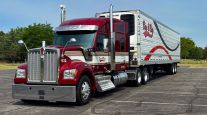ELDs: Do Your Homework Before You Buy
This story appears in the May 9 print edition of iTECH, a supplement to Transport Topics.
As carriers chart out their plans to comply with the upcoming electronic logging device mandate, one of the first questions they likely will ask is this: Which of the many devices on the market will actually meet the regulation’s requirements? One logical place to turn is the online list of registered ELDs maintained by the Federal Motor Carrier Safety Administration, but carriers should take that list with a sizable grain of salt.
To have their devices added to that registry, technology vendors merely need to “self-certify” their products. In other words, the ELDs on the list aren’t vetted by FMCSA or another third party, but by the manufacturer of the device.
 Seth Clevenger
Seth ClevengerHowever, the ELD rule does include a procedure to remove a device from that list if it is challenged by enforcement and deemed noncompliant. In that event, the device manufacturer would have an opportunity to fix any deficiencies in the product before its removal, or to appeal its delisting if it comes to that.
From the buyer’s perspective, however, the obvious danger here is that a carrier could select an ELD on the list and deploy it across its fleet, only for that device to be decertified at a later date.
BEST OF MAY iTECH: More stories, columns
Hopefully that never happens. And it may not. After all, vendors certainly have a stake in ensuring that their devices meet the standards. But the risk is there. If the ELD space is flooded with vendors looking to take advantage of the massive market created by the mandate, the odds increase that one or more will make a mistake or misinterpret a crucial detail in the rule.
For its part, FMCSA has published a test procedure designed to ensure that a device meets the requirements. Vendors aren’t actually required to follow that procedure to self-certify, however, so it’s really providing an optional aid to vendors rather than assurance to buyers.
Admittedly, a more stringent ELD certification method would have required a greater investment of time and resources, but it also would have allowed fleets to buy with confidence.
As things stand, though, carriers should view FMCSA’s registry of ELDs only as a starting point. The onus is still on the buyer to choose wisely when ELD shopping.
First-time adopters of electronic logs should be sure to select a vendor that they trust. Will that vendor continue to support the device in the years ahead? Will it be able to respond to any problems with its product or adapt to regulatory changes? How reliable will its product be? These are questions that new buyers should be asking.
The ELD mandate, which goes into effect Dec. 18, 2017, applies to nearly all drivers currently required to keep paper logbooks to record their hours of service.
However, as of mid-April, only three ELDs had been certified on FMCSA’s registry, which can be viewed at https://3pdp.fmcsa.dot.gov/ELD/ELDList.aspx.
None of the industry’s largest suppliers of electronic logging systems were on the list yet. That should change in the months ahead as those vendors plan and test software updates to make their existing devices into compliant ELDs.
The ELD rule gives early adopters of electronic logging an extra two years to comply with the new device specifications. Fleets using current e-log systems, known as automatic onboard recording devices, or AOBRDs, will not be required to update or replace them until December 2019.
Apart from the details of device certification, it’s important to remember that the deadline to have an ELD or AOBRD installed is just a year-and-a-half away.
Implementing ELDs will take time, especially for large- and medium-size fleets with many vehicles and complex business processes. It will take time to select the right product, time to deploy it across a fleet and time to train drivers and back-office personnel on how the technology works.
As several vendors and industry stakeholders have said, the initial rollout of ELDs has the potential to be quite messy as drivers and enforcement officers adapt to the technology.
Beyond that, there is a very real possibility that the industry could experience service challenges and a tightening of freight capacity in the months following implementation. Many first-time adopters will be adjusting to ELDs and perhaps recalibrating their operations to improve compliance with hours of service.
The more preparation, education and training on ELDs that occurs at the front end of this process, the smoother the transition will be.
Seth Clevenger, technology editor, can be reached at 703-838-1795 or sclevenger@ttnews.com. Follow him on Twitter @SethClevenger.




